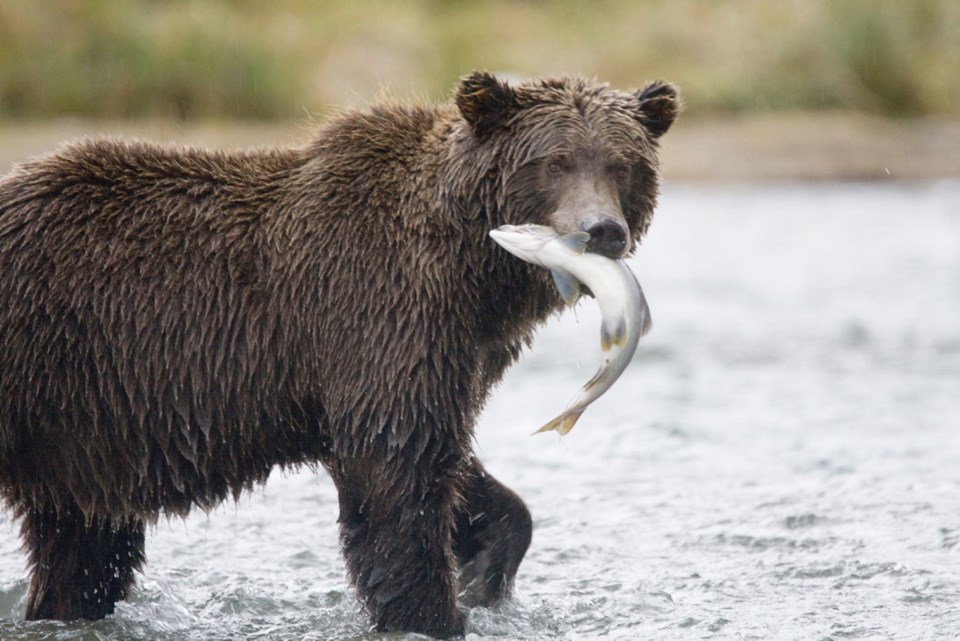British Columbia’s north and central coast, also known as the Great Bear Rainforest, along with Haida Gwaii, hosts a uniquely biodiverse region that is becoming increasingly rare in this world.
It is a place where lush forests and granite buttresses greet the sea, where grizzlies dig for clams in sight of the open Pacific, where wolves swim to distant islands in pursuit of seals, where hydrophones detect the ethereal calls of killer whales that follow salmon to freshwater rivers. In the summer, one can watch the sun set on the blows of feeding humpbacks surrounded by thousands of shearwaters, auklets and gulls that are in pursuit of tiny fish that spawn on sandy shores or on the giant kelp that buffer the fragile shoreline.
This assemblage of iconic animals makes the B.C. coast qualitatively different from most other exceptional places. It is an archipelago with a food web that knows no boundary between terrestrial and marine. Raincoast Conservation Foundation’s two decades of published science studying coastal species confirms the knowledge that First Nations have held for millennia: It is a single system where the land and ocean blend.
What befalls the ocean, befalls the species of the land. It is no place for oil tankers.
Three peer-reviewed journal publications by Raincoast scientists, and our academic partners, are directly pertinent to federal Bill C-48, which would ban oil tankers in the vast coastal area described above. First is a paper that was produced from 10,000 nautical miles of line-transect surveys Raincoast conducted of marine mammals and birds through the waters that Bill C-48 addresses, an area referred to as the Queen Charlotte Basin.
The paper, “Quantifying marine mammal hotspots in British Columbia,” is a response to the overwhelming evidence that humans are contributing to rapid declines in marine species, particularly in coastal areas. We found that southeastern Haida Gwaii, outer Queen Charlotte Sound near the Scott Islands, Chatham Sound and Dixon Entrance, Caamano Sound, Calvert Island and Aristazabal Island were all identified as places of exceptionally high marine-mammal abundance. These areas all lie within the waters identified by Bill C-48.
A second paper, “Oil Spills and marine mammals: developing a risk-based conceptual framework,” evaluates the consequences of potential oil exposure on 21 species of B.C. marine mammals. All marine mammals are inherently vulnerable to oil spills because they live their lives at the air-water interface, often the location where oil contact, inhalation or ingestion would first occur in the event of a spill.
We found that B.C.’s populations of killer whales, Steller sea lions and sea otters ranked particularly high in terms of overall vulnerability to oil spills. Their elevated risk above other marine mammals is due to their small populations, slow reproductive rates, specialized diets and the tendency for large percentages of the population to be grouped together in space or time.
The third paper, “Marine birds and chronic oil pollution on Canada’s Pacific coast,” identifies marine bird species considered to be at elevated risk of extinction and those with a pronounced vulnerability to oil spills and climate change. Marine birds in this region are vulnerable to oil exposure in any volume, from spills small or large. Bill C-48 reduces the possibility of catastrophic oil spills to at-risk species and their habitats.
Lastly, an important consideration within Bill C-48 is that it does not only address the unacceptable risk of oil spills, it also captures the growing problem of underwater shipping noise. The rapid expansion of research on ocean noise has identified many species, from crustaceans to fish to whales, that depend on sound to find food, communicate, avoid predators and survive. As such, the effects from underwater noise can be extensive and include injury, habitat avoidance and abandonment, masking of important communication, loss of feeding ability, chronic stress and reduced reproductive success.
Bill C-48 also considers the growing threat of ship strikes. Similar to the East Coast, increased shipping increases the concern for ship strikes on large baleen whales such as the Pacific coast’s fin, sei, humpback and the handful of critically endangered North Pacific right whales that inhabit these waters.
One hundred years ago, humpback and fin whales were largely extirpated from the inside waters of the B.C. coast. As the federal government looks to codify a 35-year moratorium on oil-tanker traffic into law, these whales are returning to their historic feeding grounds.
While we continue our work to ensure the priceless and irreplaceable B.C. coast can continue its unparalleled evolutionary journey, we will mark Bill C-48 as an important and necessary step in ensuring that future.
Misty MacDuffee is a conservation biologist with Raincoast Conservation Foundation. Chris Genovali is Raincoast’s executive director.



